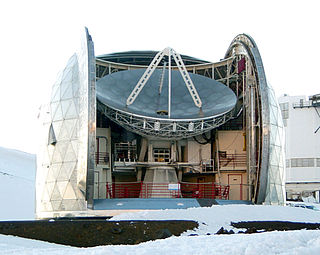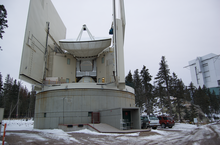
Infrared astronomy is astronomical observation of astronomical objects using infrared (IR) radiation. The wavelength of infrared light ranges from 0.75 to 300 micrometers. Infrared falls in between visible radiation, which ranges from 380 to 750 nanometers, and submillimeter waves.

Lowell Observatory is an astronomical observatory in Flagstaff, Arizona, United States. Lowell Observatory was established in 1894, placing it among the oldest observatories in the United States, and was designated a National Historic Landmark in 1965. In 2011, the Observatory was named one of "The World's 100 Most Important Places" by TIME. It was at the Lowell Observatory that the dwarf planet Pluto was discovered in 1930 by Clyde Tombaugh.

Safford is a city in Graham County, Arizona, United States. According to the 2010 Census, the population of the city is 9,566. The city is the county seat of Graham County.

The Large Binocular Telescope (LBT) is an optical telescope for astronomy located on 10,700-foot (3,300 m) Mount Graham, in the Pinaleno Mountains of southeastern Arizona, United States. It is a part of the Mount Graham International Observatory.

The Mauna Kea Observatories (MKO) are a number of independent astronomical research facilities and large telescope observatories that are located at the summit of Mauna Kea on the Big Island of Hawaiʻi, United States. The facilities are located in a 525-acre (212 ha) special land use zone known as the "Astronomy Precinct", which is located within the 11,228-acre (4,544 ha) Mauna Kea Science Reserve. The Astronomy Precinct was established in 1967 and is located on land protected by the Historical Preservation Act for its significance to Hawaiian culture. The presence and continued construction of telescopes is highly controversial due to Mauna Kea's centrality in native Hawaiian religion and culture, as well as for a variety of environmental reasons.

Steward Observatory is the research arm of the Department of Astronomy at the University of Arizona (UA). Its offices are located on the UA campus in Tucson, Arizona (US). Established in 1916, the first telescope and building were formally dedicated on April 23, 1923. It now operates, or is a partner in telescopes at five mountain-top locations in Arizona, one in New Mexico, one in Hawaii, and one in Chile. It has provided instruments for three different space telescopes and numerous terrestrial ones. Steward also has one of the few facilities in the world that can cast and figure the very large primary mirrors used in telescopes built in the early 21st century.

The Atacama Large Millimeter/submillimeter Array (ALMA) is an astronomical interferometer of 66 radio telescopes in the Atacama Desert of northern Chile, which observe electromagnetic radiation at millimeter and submillimeter wavelengths. The array has been constructed on the 5,000 m (16,000 ft) elevation Chajnantor plateau - near the Llano de Chajnantor Observatory and the Atacama Pathfinder Experiment. This location was chosen for its high elevation and low humidity, factors which are crucial to reduce noise and decrease signal attenuation due to Earth's atmosphere. ALMA is expected to provide insight on star birth during the early Stelliferous era and detailed imaging of local star and planet formation.

Mount Graham is a mountain in Graham County, Arizona, United States, approximately 70 miles (110 km) northeast of Tucson. The mountain reaches 10,724 feet (3,269 m) in height. It is the highest elevation in Graham County, Coronado National Forest and the Pinaleño Mountains. It is also the southernmost peak and land area in the continental United States above 10,000 feet (3,048 m). As the name "Mount Graham" is often used by locals to refer to the entire mountain range, the peak itself is frequently referred to as "High Peak". It is twentieth of the 57 ultra prominent peaks of the lower 48 states, and the first of the five in Arizona.

The Caltech Submillimeter Observatory (CSO) was a 10.4-meter (34 ft) diameter submillimeter wavelength telescope situated alongside the 15-meter (49 ft) James Clerk Maxwell Telescope (JCMT) at Mauna Kea Observatories. It was engaged in submillimeter astronomy, of the terahertz radiation band. The telescope closed on September 18, 2015. As of April 2019, the telescope is set to be dismantled and its site remediated in the near future as part of the Mauna Kea Comprehensive Management Plan.

The Submillimeter Array (SMA) consists of eight 6-meter (20 ft) diameter radio telescopes arranged as an interferometer for submillimeter wavelength observations. It is the first purpose-built submillimeter interferometer, constructed after successful interferometry experiments using the pre-existing 15-meter (49 ft) James Clerk Maxwell Telescope and 10.4-meter (34.1 ft) Caltech Submillimeter Observatory as an interferometer. All three of these observatories are located at Mauna Kea Observatory on Mauna Kea, Hawaii, and have been operated together as a ten element interferometer in the 230 and 345 GHz bands. The baseline lengths presently in use range from 16 to 508 meters. The radio frequencies accessible to this telescope range from 194–408 gigahertz (1.545–0.735 mm) which includes rotational transitions of dozens of molecular species as well as continuum emission from interstellar dust grains. Although the array is capable of operating both day and night, most of the observations take place at nighttime when the atmospheric phase stability is best.

Submillimetre astronomy or submillimeter astronomy is the branch of observational astronomy that is conducted at submillimetre wavelengths of the electromagnetic spectrum. Astronomers place the submillimetre waveband between the far-infrared and microwave wavebands, typically taken to be between a few hundred micrometres and a millimetre. It is still common in submillimetre astronomy to quote wavelengths in 'microns', the old name for micrometre.

The 1.8 meter Alice P. Lennon Telescope and its Thomas J. Bannan Astrophysics Facility, known together as the Vatican Advanced Technology Telescope (VATT), is a Gregorian telescope observing in the optical and infrared situated on Mount Graham in southeast Arizona, United States. It achieved its first light in 1993.

Mount Graham International Observatory (MGIO) is a division of Steward Observatory, the research arm for the Department of Astronomy at The University of Arizona, in the United States. It is located in southeastern Arizona's Pinaleño Mountains near Mount Graham.

Associated Universities, Inc. (AUI) is a research management corporation that builds and operates facilities for the research community. AUI is a not-for-profit 501(c)(3) corporation, headquartered in Washington, DC. The President is Dr. Adam Cohen. AUI's major current operating unit is the National Radio Astronomy Observatory (NRAO), which it operates under a Cooperative Agreement with the National Science Foundation.

The Atacama Submillimeter Telescope Experiment (ASTE) is a 10-meter-diameter antenna built by Mitsubishi Electric as a preprototype for ALMA.

The ARO 12m Radio Telescope is a 12-meter dish located on Kitt Peak, approximately 60 mi (100 km) from Tucson in Arizona at an elevation of 6215.8 ft.

The Large Latin American Millimeter Array (LLAMA) is a single-dish 12 m Nasmyth optics antenna which is under construction in the Puna de Atacama desert in the Province of Salta, Argentina. The primary mirror accuracy will allow observation from 40 GHz up to 900 GHz. It is also planned to install a bolometer camera at millimeter wavelengths. After installation it will be able to join other similar instruments to perform Very Large Base Line Interferometry or to work in standalone mode. Financial support is provided by the Argentinian and Brazilian governments. The total cost of construction, around US$20 million, and operation as well as the telescope time use will be shared equally by the two countries. Construction planning started in July 2014 after the formal signature of an agreement between the main institutions involved.
The Leighton Radio Telescopes are 10.4 meter parabolic dish antennas designed by Robert B. Leighton in the 1970s, which were fabricated on the Caltech campus during the 1970s and 1980s. The telescope surfaces reached an accuracy of 10 microns RMS, allowing observations throughout the millimeter and submillimeter bands. In all, eight of these telescopes were made. They were used as the six elements of the Owens Valley Radio Observatory (OVRO) millimeter interferometer in California, and as single telescopes at the Caltech Submillimeter Observatory in Hawaii and the Raman Research Institute (RRI) at Bangalore, India. In the spring of 2005, the six Leighton telescopes in Owens Valley were moved to a high mountain site in the White Mountains to form the core of the CARMA array of 25 telescopes. The CARMA array was decommissioned in 2015 at which time the Leighton telescopes were moved back to OVRO, where they are now being repurposed for different projects including the CO Mapping Array Pathfinder (COMAP), the Event Horizon Telescope (EHT), and various transient detection projects.


















